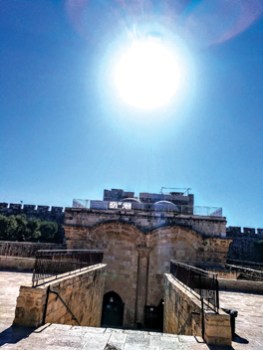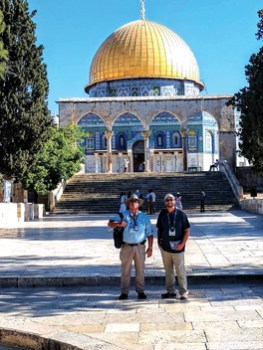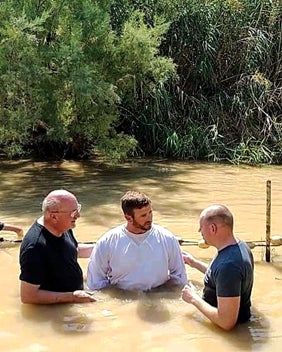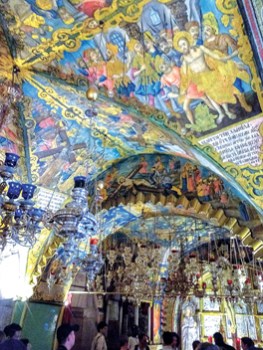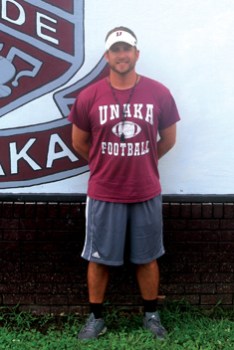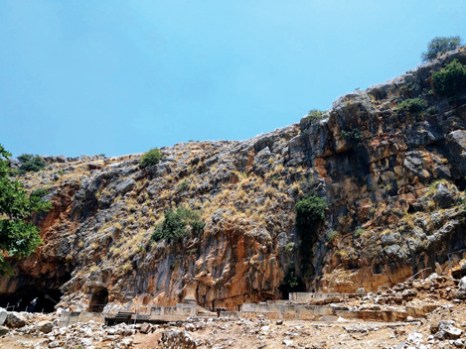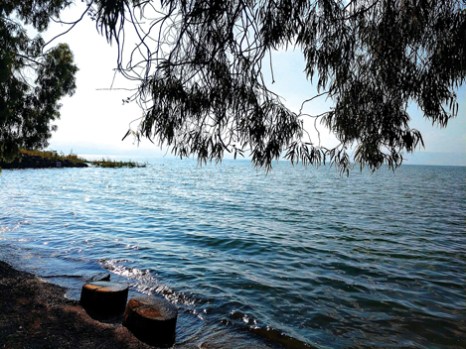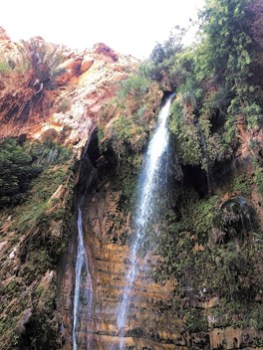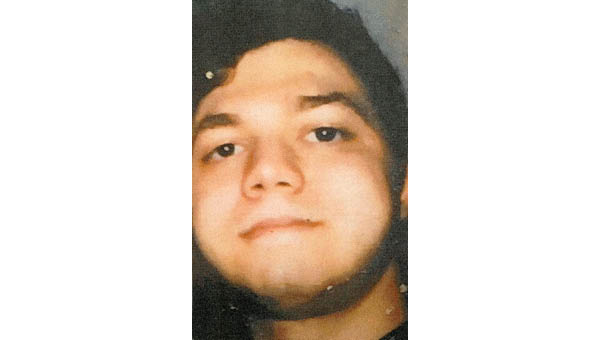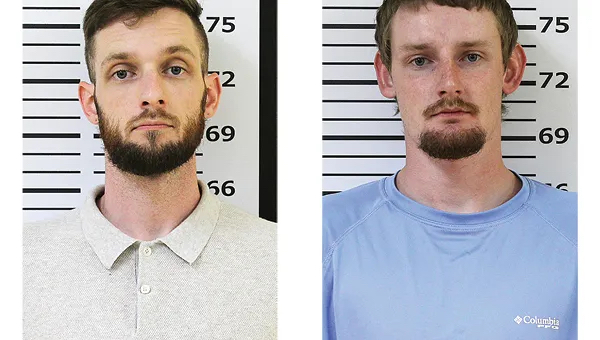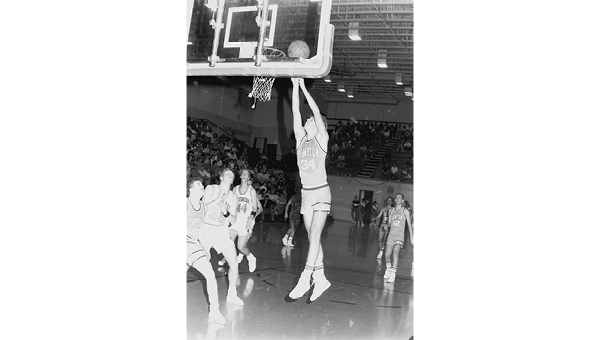Unaka’s Bennett travels paths Jesus trod on trip to Israel
Published 9:45 am Monday, July 29, 2019
1 of 18
Photo Contributed
Sun over the Eastern Gate, Ezekiel 43 and Zechariah 14 say this is where Jesus will enter when he returns.
Photo Contributed
View of Jerusalem from the Mount of Olives.
Photo Contributed
Dome of the rock from the Temple Mount.
Photo Contributed
Getting Baptized in the Jordan River. This is the same location Jesus was Baptized by John. It is at the ford in the river where the ancient main road crossed into modern Israel going up to Jerusalem. It is also very near to the entrance to the Dead Sea. This means that when Jesus began his ministry, he was baptized at the the lowest place on Earth. The water is muddy and brackish. As you go under, you descend into complete darkness within a foot of the surface. But out of that darkness, in the most humble position on earth, beneath every human on the planet, Jesus went lower. Then, he was raised into light and stepped up toward Jerusalem to begin his ministry.
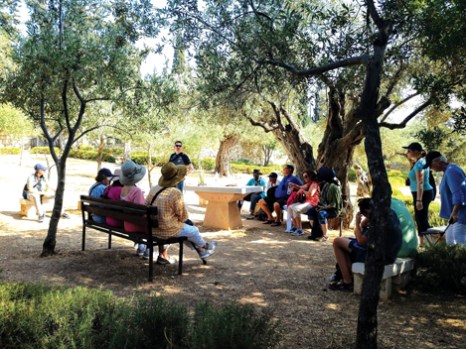
Photo Contributed
Taking the Lord's Supper on The Mount of Olives/Garden of Gethsemane. The Garden of Gethsemane, it was here where Jesus went to pray and was arrested and taken for crucifixion. In the first century, the "Garden" was an olive oil press, and it was from this press that the annointing oil for Kings was made. Some of the trees pictured are over 1500 years old. The Mount of Olives is a very important place in scripture and prophesy. It was here that the Glory of God stopped as it departed from the Temple through the Eastern Gate in Ezekiel 10-11, here that Jesus ascended to heaven as described in Luke 24 and Acts 1, and it is here that He will return as stated in Ezekiel 43 and Zechariah 14. Jesus himself prophesied on the Mount of Olives in the days before his crucifixion telling the people to "watch and pray" as they await his return (Luke 21:36, Matthew 24:42)Interestingly, he uses a similar phrase here soon after, when he found his disciplines asleep in Matthew 26: "40And he came to the disciples and found them sleeping. And he said to Peter, “So, could you not watch with me one hour?
41Watch and pray that you may not enter into temptation. The spirit indeed is willing, but the flesh is weak.” The use of the same phrase in the same location soon after the lesson was likely meant to emphasize the point. Like Peter, it is important that we are not lulled to sleep, but that we continually "watch and pray".
Photo Contributed
For He is not here, but has risen as he hath said--the Empty Tomb!
Photo Contributed
At the Holy Sepulchre, there are six different denominations that run the place, each trying to out church the other. There is actually a ladder leaning against the window at the Holy Sepulchre andhas been there since 1852 and no one will move it.
Photo Contributed
Inside the Holy Sepulchre.
Star Photo/Ivan Sanders
Unaka High School educator and head football coach O'Brien Bennett spent a father and son trip of a lifetime recently as he and his father traveled to Israel and spent 10 days walking in the footsteps of Jesus to bring a new light to the stories that are contained on the the pages of the Bible.
Photo Contributed
Day 3: We spent the day around the North West portion of the sea of Galilee. During the time of Christ, 7 warm water springs ran into the lake between Magdala and the Jordan River. This made this part of the Galilee a thriving fishing industry. Our first stop of the day was the Primacy of Peter, the location that it is thought Jesus meets Peter after the resurrection and asks him "Do you love (agape) me" twice and the third time asked "Do you love (phileo) me" (John 21). This is one of only 2 passages in the Bible where a charcoal fire is mentioned. The other being where Peter denied he knew him. Here we saw a first century dock where fishermen, including Jesus' disciples, would have docked their boats, unloaded their catch, and mended their nets. After that, we left and took a boat ride into the Sea of Galilee around to where Jesus walked on water. Pictured is where Jesus called Peter at the docks.

Photo Contributed
Day 2: After Mount Carmel, we travelled Eastward to the boyhood home of Jesus Christ, Nazareth. Nazareth literally means "The town of the shoot". Isaiah 11 speaks of the coming Messiah and opens with verse 1 "Then a shoot will spring up from the stump of Jesse, and a Branch from his roots will bear fruit." Nazareth was a backwater. It was a tiny village nestled in the niche between two hills. "Can anything good come from Nazareth?" they asked in John. We went to the traditional, though unlikely historical, site of Mount Precipice spoken of in Luke 4:16-30. All eyes were on him because he didn't finish reading the scripture. He simply rolled up the scroll and said it was fulfilled through him. While this is likely not the historical spot due to its distance from the synagogue, I find it likely that Jesus sat on these very rocks and enjoyed this view from time to time. That he played in these hills as a boy. We were delivered a message right here where Jesus lived from the time he left Egypt until he was 30 years old. Then it struck us, the Valley between the hills. The view directly through the hills from Old Nazareth...it was directly of Megiddo. Every day when Jesus walked out his door he would see the fields of Armageddon. Nazareth is the place where the gospel story began, when an Angel visited a young girl and Armageddon is where the final victory will be won. I doubt this fact was lost on Him each morning.
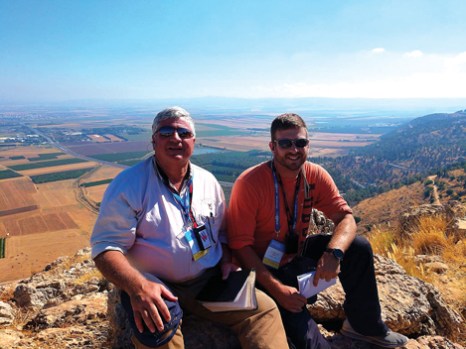
Photo Contributed
Day 2: After Mount Carmel, we travelled Eastward to the boyhood home of Jesus Christ, Nazareth. Nazareth literally means "The town of the shoot". Isaiah 11 speaks of the coming Messiah and opens with verse 1 "Then a shoot will spring up from the stump of Jesse, and a Branch from his roots will bear fruit." Nazareth was a backwater. It was a tiny village nestled in the niche between two hills. "Can anything good come from Nazareth?" they asked in John. We went to the traditional, though unlikely historical, site of Mount Precipice spoken of in Luke 4:16-30. All eyes were on him because he didn't finish reading the scripture. He simply rolled up the scroll and said it was fulfilled through him. While this is likely not the historical spot due to its distance from the synagogue, I find it likely that Jesus sat on these very rocks and enjoyed this view from time to time. That he played in these hills as a boy. We were delivered a message right here where Jesus lived from the time he left Egypt until he was 30 years old. Then it struck us, the Valley between the hills. The view directly through the hills from Old Nazareth...it was directly of Megiddo. Every day when Jesus walked out his door he would see the fields of Armageddon. Nazareth is the place where the gospel story began, when an Angel visited a young girl and Armageddon is where the final victory will be won. I doubt this fact was lost on Him each morning.
Photo Contributed
Our last stop of the day was Magdala or Migdal. This was the home of Mary Magdalene. What makes this site unique is that it was only discovered 10 years ago, so there is no church or landmark, only the original town. Situated at the foot of Mr. Arbel on the Via Maris, Magdala was the first stop in Galilee for any travelers or traders. It was also the site of fish processing industry, making it a likely stopping point for Galilean fishermen after a large catch. We know from Matthew 4:23 that Jesus ministered in this Synagogue, walked the steps in this market, and performed miracles here, on these stones. That made this place so much more incredible and humbling, knowing I'm not walking "near" where Jesus walked, or in a church built on the site. Jesus literally set foot on these stones where I stand. He taught in the room I am now in. He read the Scriptures....here. Pictured is the synagogue where he would have taught.
Photo Contributed
Day 4: Caesarea Phillipi. One of the big revelations of this journey has been how the geography of Israel is part of the theology. Caesarea Phillipi is a prime example. Built by Herod the Great's son, Philip the Tetrach as "Phillip's City dedicated to Caesar", this city stood in stark contrast to the teachings of Jesus. Built adjacent to the Roman resort of Banias springs at the source of the Jordan River, this town had all the hedonism the Hellenistic world had to offer (Including my favorite, the Temple of Pan and the Dancing Goats... that would make a great name for a band). The large cave out of which the spring flowed was known as "The Gates of Hades" and directly in front was a Temple to Caesar and Jupiter. Smaller temples littered the grounds. It was within view of these that Matthew 16:13-20 transpired. In contrast to this enormous rock pictured where, at the mouth of "The Gates of Hades" (Far left) stood a "church" of Caesar.
Photo Contributed
Day 3: We spent the day around the North West portion of the sea of Galilee. During the time of Christ, 7 warm water springs ran into the lake between Magdala and the Jordan River. This made this part of the Galilee a thriving fishing industry. Our first stop of the day was the Primacy of Peter, the location that it is thought Jesus meets Peter after the resurrection and asks him "Do you love (agape) me" twice and the third time asked "Do you love (phileo) me" (John 21). This is one of only 2 passages in the Bible where a charcoal fire is mentioned. The other being where Peter denied he knew him. Here we saw a first century dock where fishermen, including Jesus' disciples, would have docked their boats, unloaded their catch, and mended their nets. After that, we left and took a boat ride into the Sea of Galilee around to where Jesus walked on water. Pictured is the traditional site where Jesus met Peter after his resurrection.
Photo Contributed
Day 5: En Gedi. I got to hike again. This time to where many of David's Psalms were written or inspired and to where he spared King Saul but cut the tassle of his robe. Situated on the Dead Sea, this oasis is the only fresh water available in the wilderness, so this is most certainly where David would have been at this time. The wild goats were very common in crags above the spring. It is not hard to imagine David sitting here gaining inspiration from the Lord for many of his Psalms or composing Psalm 27.
Photo Contributed
Day 5: En Gedi. I got to hike again. This time to where many of David's Psalms were written or inspired and to where he spared King Saul but cut the tassle of his robe. Situated on the Dead Sea, this oasis is the only fresh water available in the wilderness, so this is most certainly where David would have been at this time. The wild goats were very common in crags above the spring. It is not hard to imagine David sitting here gaining inspiration from the Lord for many of his Psalms or composing Psalm 27.
Photo Contributed
The ancient gates of Laish. These gates were built over 4,000 years ago. Their use of arches predates the Greeks and Romans. This is the oldest known arch in the world. The construction is of mud brick rather than stone allowing the structure to be earthquake proof as the mud bricks shift with the earth. Abraham himself would have walked up these steps and passed through the gates as he went to rescue Lot during the events of Genesis 14 and 15. Later, in Judges 18, the tribe of Dan conquers the city and rebuilds, renaming it Dan. It is likely at this time that the old gates were replaced, filled in and covered to be lost for the next 3,000 years.
When reading the Bible, it’s difficult sometime to understand precisely what it was like during Jesus Christ’s time here on Earth and the places he visited.
However, a lot of that changed recently for Unaka High School head football coach O’Brien Bennett whose eyes were opened tremendously when he and his father, Kevin, took one of those trips of a lifetime traveling to Israel.
“It’s always been a bucket-list item for me,” Bennett said of the trip. “I have read and studied the Bible but I have done so from a distance — from a 21st-century western perspective.
“So I have always wanted to go over there and see it as it was to bring to life the stories and to take a two-dimensional page on a book and make it a three or four-dimensional understanding.
“The opportunity arose this spring when my father called and asked if I would be interested in making a father and son trip and so this was a once-in-a-lifetime opportunity,” Bennett continued.
“I grew up with brothers so all of our trips were family trips and we never had a one-on-one trip him and me. He’s in his 60s now and that just made it that once-in-a-lifetime opportunity to do something like that but especially with my father.”
Bennett said that the trip changed so many different things and ways that he perceived the stories that were recorded in the Holy Scriptures over 2000 years ago.
“There were some big takeaways,” said Bennett. “So much of the Bible was written toward a first-century Jewish person from a Jewish perspective — the feast, the holidays, the law.
“But also the geography of Israel. So much of it is the scenes where Jesus is preaching or events occurred.
“Israel is roughly the size of East Tennessee so many of these things happened in the same place so when they are speaking, they are speaking and referring to events that happened within sight of the viewers,” Bennett continued.
“For example, in Caesarea Phillipi, there was a large Roman resort called Baniyas, where temples for Jupiter and Pan predominantly existed. In the mountain, these temples were carved into the rock face where there is a giant cave the Jews called the Gates of Hell.
“Jesus goes here and teaches his disciples and tells Simon Peter that on this rock, I will build my church and the Gates of Hell shall not prevail against it.
“When you read that in the Bible, that is something that you would miss.”
Bennett compared the explosion of knowledge to be like standing in a small foyer and then walking into a large room of understanding.
When others speak of traveling to Israel, there are often stories where personal lives are forever changed by visiting some of the locations where historical accounts of the Bible unfolded.
Bennett shared one of those personal stories from his trip.
“In Migdal, one of the events that occurred there was when Jesus was coming off a boat heading back to Nazareth and the road to Nazareth led through Migdal,” Bennett stated. “When he got out of the boat, people began pressing around him and a woman reached out and touched the hem of His garment and in this throng of people he stops and asks, “Who touched me?”
“We were able to have a worship service in the general vicinity of where that happened and we had a prayer service and I was able to pray for people in my life with sickness or illness.
“While I was doing that, with Jesus being God at the time that event happened in the Bible, He knew that 2000 years later I would be standing in the very same place praying for my son and his healing,” continued Bennett.
“He knew that I would be there and He thought of my son and me. He transcends time and He knew that we would be there praying 2000 years later for healing for people in my life and my son.”
Bennett said that another important event in his spiritual life was the opportunity to be baptized in the same river that Jesus was, the Jordan River.
“It had never occurred to me that the place where Jesus was baptized was the crossing place for the Jews — it was a common ford where the road from Galilee crossed back over Jordan going back up to Jerusalem,” said Bennett.
“We were 1400 feet below sea level, the lowest place on Earth, and Jesus went into the Jordan with John the Baptist below ever human being ever to be on this planet.
“When you go under the water, within six to eight inches under the water because it is so brackish, the water becomes pitch black,” Bennett continued.
“So as you go under you go into complete darkness below everybody on planet Earth and then you come up into the light of the blazing sun and you are looking straight into Jerusalem as Jesus did.
“It was just something to be able to experience that life-changing event in my life.”


